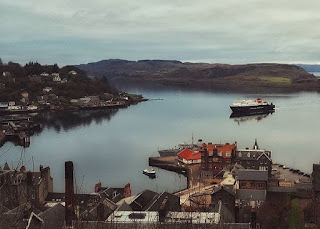 "On the West Coast of Scotland, there's a small town called Oban. Be careful...you may fall in love."
"On the West Coast of Scotland, there's a small town called Oban. Be careful...you may fall in love."
About Oban
Your first view of Oban is one you are unlikely to forget. From the north, you glimpse this bustling port from the top of the 'Bealach-an-Righ'. As you sweep down the hill towards the expanse of the bay, the view opens up before you and one begins to appreciate why Oban has developed into Scotland's most popular west-coast holiday town.
Read about the history of the town below and explore the rest of the site to find out more about this beautiful area of Scotland.
Beyond Oban ("little bay" in Gaelic - Scotland's ancient Celtic language) lie the islands of the Inner Hebrides: Kerrera, which protects the town from Atlantic storms; the low, green island of Lismore; majestic Mull, and the granite mountains of the Morvern peninsula. Beyond them, the sacred island of Iona, Coll, Colonsay and Tiree.
 Oban today has a resident population of 8,500 and is the unofficial capital of the West Highlands - the "Gateway to the Isles" - however it has recently become better known as "The Seafood Capital of Scotland". The panoramic views of the mountains, lochs and islands which have captivated artists, authors, composers, and poets for centuries are as striking now as they were when Dunollie Castle, a ruined keep which has stood sentinel over the narrow entrance to the sheltered bay for around six hundred years, was the northern outpost of the Dalriadic Scots.
Oban today has a resident population of 8,500 and is the unofficial capital of the West Highlands - the "Gateway to the Isles" - however it has recently become better known as "The Seafood Capital of Scotland". The panoramic views of the mountains, lochs and islands which have captivated artists, authors, composers, and poets for centuries are as striking now as they were when Dunollie Castle, a ruined keep which has stood sentinel over the narrow entrance to the sheltered bay for around six hundred years, was the northern outpost of the Dalriadic Scots.
It is no surprise to find Oban in the 21st Century remains a magnet for travellers from all over the world. The town's present day popularity owes much to the Victorians, and as early as 1812, when the Comet steamship linked Oban with Glasgow, the town played host to intrepid travellers touring Staffa - the inspiration for Mendelssohn's Hebridean Overture - and Iona - home of Scottish Christianity since St Columba stepped ashore in AD563.
Indeed once Oban had the royal seal of approval from Queen Victoria, who called it "one of the finest spots we have seen", the town's destiny as an endearingly enchanting holiday destination was as firmly set as the lava columns of Fingal's Cave in Staffa.

No comments:
Post a Comment